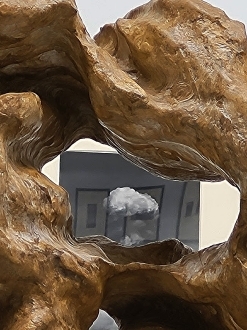The Power and the Glory by Connor Hirst in south London
THE NEWPORT STREET Gallery, which is in a side street not far from Lambeth Palace and the Garden Museum, was opened in October 2015. Housed in a building originally built in 1913 as a theatre carpentry and scenery production workshop, these spacious premises are used to display selections from the huge number of works that have been collected over the years by the artist Damien Hirst. The current exhibition, which has been curated by Damien’s son Connor Hirst, is called “The Power and the Glory”, and is showing until 31 August 2025.
The walls of the rooms in the gallery are lined with photographs of atomic and hydrogen bomb test explosions (‘mushroom clouds’ etc.), as well as of the devastation that the former caused in Hiroshima and Nagasaki. Although many of the photographs are beautiful as works of art, they are grim reminders of the horrific destructive forces unleashed by detonating nuclear bombs. However, as the curator explained, many of the photographs have been composed in such a way that the viewer is unaware of the destruction going on beneath the picturesque clouds.

While the walls of the rooms are lined with photographs, the rooms contain many beautifully shaped (mostly shaped by nature) pieces of rock. They include a selection of so-called ‘scholar’s rocks’. These have been collected in China since the Song Dynasty (960-1279 AD), and appreciated for their inherent beauty. Most of them were found either in caves in Guandong province or at Lake Tai or in the Lingbi region. Amongst the collection of scholar rocks, there are some Japanese ‘water stones’, which are often shaped like mountains and waterfalls.
The stones are intrinsically beautiful and provide an interesting contrast to the photographs surrounding them. However, although the rocks and photographs served different functions, when displayed together as they are at the Newport Street Gallery, they cannot help becoming interlinked in the viewers’ minds. I could not help thinking that these rocks could easily have been similar to the fragments of buildings destroyed by the bombs at Hiroshima and Nagasaki.



